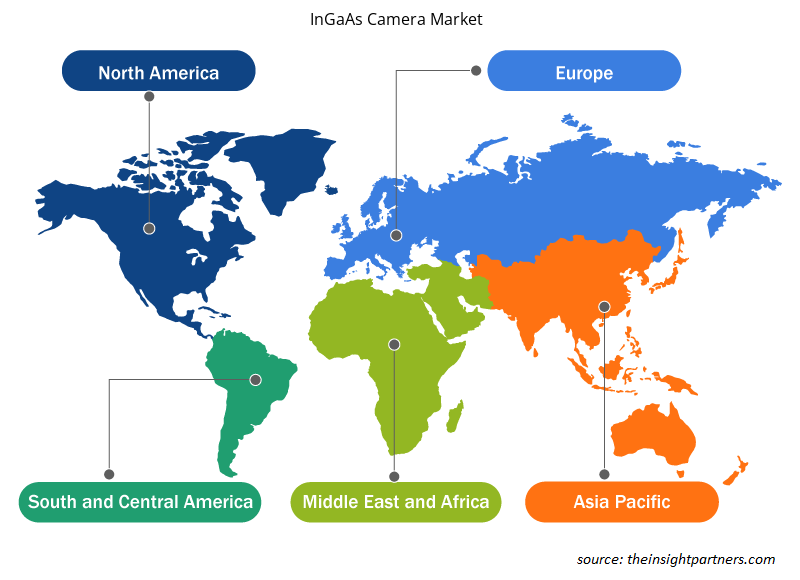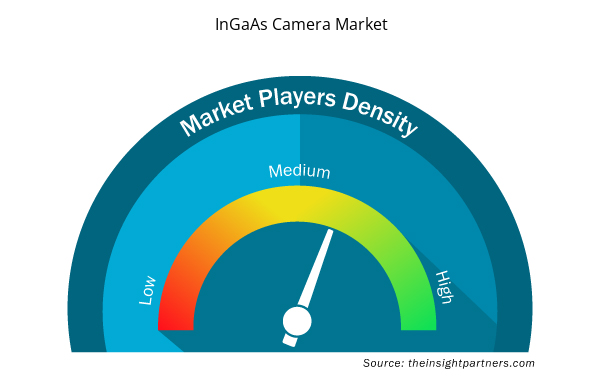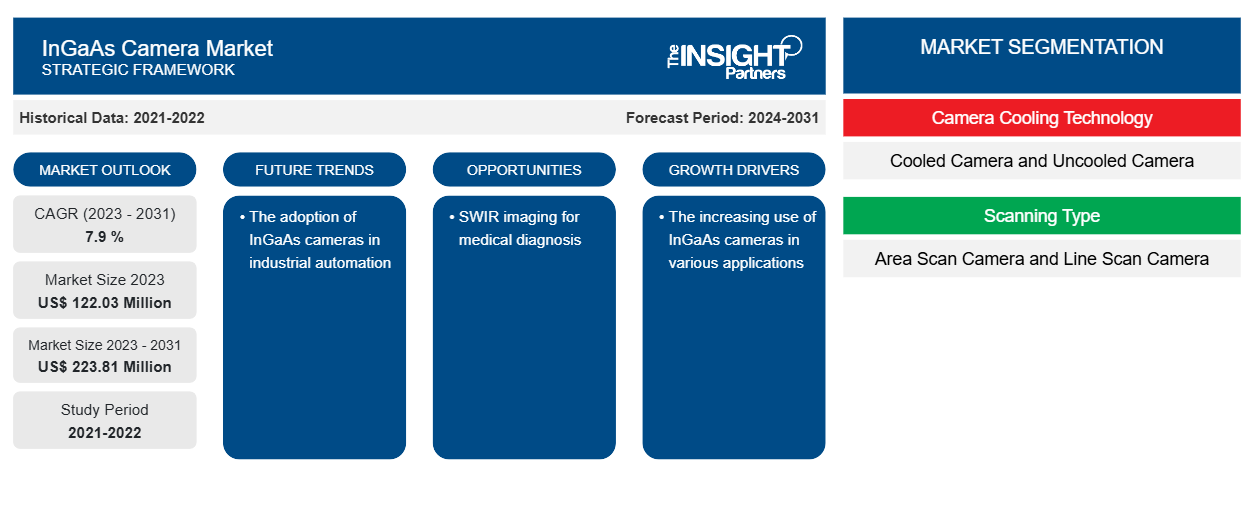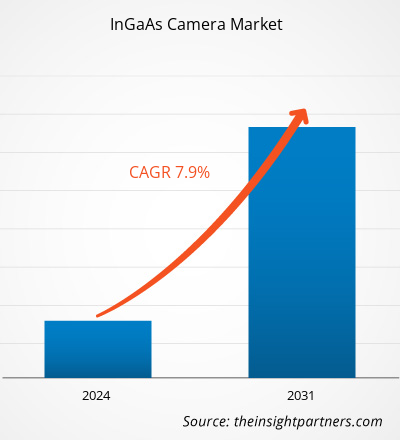Si prevede che la dimensione del mercato delle telecamere InGaAs raggiungerà i 223,81 milioni di dollari entro il 2031, rispetto ai 122,03 milioni di dollari del 2023. Si prevede che il mercato registrerà un CAGR del 7,9% nel periodo 2023-2031. È probabile che l'adozione di telecamere InGaAs nell'automazione industriale rimanga una tendenza chiave nel mercato.
Analisi del mercato delle fotocamere InGaAs
La crescita del mercato delle telecamere InGaAs è attribuita al crescente utilizzo di queste telecamere in varie applicazioni, come l'automazione industriale e la diagnosi medica . Una telecamera SWIR può prevenire questo problema e quindi garantire un processo di produzione regolare. Pertanto, l'aumento dell'utilizzo delle telecamere InGaAs in varie applicazioni sta guidando il mercato delle telecamere InGaAs. Vengono inoltre discusse tecniche di imaging SWIR, come l'imaging iperspettrale SWIR per applicazioni biomediche e un sistema microscopico olografico digitale a banda larga (VIS+SWIR) basato su un nuovo sensore di immagini a punti quantici (QD). Pertanto, l'aumento dell'utilizzo delle telecamere InGaAs in varie applicazioni sta guidando il mercato.
Panoramica del mercato delle fotocamere InGaAs
I sensori InGaAs sono utilizzati per la rilevanza nelle scienze fisiche e biologiche e richiedono un'elevata sensibilità nell'intervallo di lunghezza d'onda 900-1700 nm, noto come infrarosso a onde corte (SWIR). Alcuni sensori InGaAs possono misurare fino a 2500 nm a causa delle modifiche nella composizione del materiale. Sebbene le telecamere CCD basate sul silicio possiedano sensibilità nell'intervallo UV-NIR, le proprietà di bandgap del silicio impediscono a queste CCD di avere una sensibilità sufficiente oltre 1100 nm. Le telecamere InGaAs hanno un bandgap inferiore, rendendo questo materiale il materiale preferito per applicazioni nella regione dell'infrarosso a onde corte (SWIR).
Personalizza questo report in base alle tue esigenze
Riceverai la personalizzazione gratuita di qualsiasi report, comprese parti di questo report, o analisi a livello nazionale, pacchetto dati Excel, oltre a usufruire di grandi offerte e sconti per start-up e università
- Scopri le principali tendenze di mercato in questo rapporto.Questo campione GRATUITO includerà analisi di dati che spaziano dalle tendenze di mercato alle stime e alle previsioni.
Driver e opportunità del mercato delle fotocamere InGaAs
L'uso crescente di telecamere InGaAs in varie applicazioni
L'ispezione di cristalli e lingotti di silicio (noti anche come mattoni) è una delle applicazioni più popolari per le telecamere InGaAs nel settore dei semiconduttori. La capacità di vedere nel silicio a una gamma di lunghezze d'onda superiore a 1.150 nm fornisce alle telecamere InGaAs una soluzione adatta per il rilevamento di inclusioni, come impurità all'interno di un cristallo o di un lingotto, che possono accumularsi durante il processo di produzione. Le impurità sono critiche quando si osservano i lingotti in sottili wafer con una catena di diamante. Se la catena colpisce un elemento, come un piccolo pezzo di metallo, la catena eccezionalmente costosa può rompersi. Non solo la sostituzione di una catena genera un costo, ma porta anche a una minore produttività e a profitti ridotti. Una telecamera SWIR può prevenire ciò e quindi garantire un processo di produzione regolare. Pertanto, l'aumento dell'uso di telecamere InGaAs in varie applicazioni sta guidando il mercato delle telecamere InGaAs.
Immagini SWIR per diagnosi medica
L'imaging SWIR è utilizzato nella diagnosi medica. Le tecniche in via di sviluppo basate sulla luce SWIR, tra cui la fabbricazione e l'uso di nanoparticelle SWIR come agenti fototermici e nanotermometri luminescenti, e i recenti progressi nella struttura, progettazione e applicazioni biomediche correlate a SWIR di nanoparticelle drogate con terre rare (REDN). Le REDN sono tra gli emettitori SWIR più altamente luminosi e biocompatibili. Vengono inoltre discusse le tecniche di imaging SWIR, come l'imaging iperspettrale SWIR per applicazioni biomediche e un sistema microscopico olografico digitale a banda larga (VIS+SWIR) basato su un nuovo sensore di immagini a punti quantici (QD). Pertanto, l'aumento dell'uso di telecamere InGaAs in varie applicazioni sta guidando il mercato.
Analisi della segmentazione del rapporto di mercato delle fotocamere InGaAs
I segmenti chiave che hanno contribuito alla derivazione dell'analisi di mercato delle telecamere InGaAs sono la tecnologia di raffreddamento della telecamera, il tipo di scansione e l'applicazione.
- In base alla tecnologia di raffreddamento della fotocamera, il mercato delle fotocamere InGaAs è suddiviso in fotocamere raffreddate e fotocamere non raffreddate. Il segmento software ha detenuto una quota di mercato maggiore nel 2023.
- In base al tipo di scansione, il mercato è segmentato in telecamere a scansione d'area e telecamere a scansione lineare.
- In base all'applicazione, il mercato è segmentato in militare e difesa, automazione industriale e ricerca scientifica.
Analisi della quota di mercato delle fotocamere InGaAs per area geografica
L'ambito geografico del rapporto sul mercato delle fotocamere InGaAs è suddiviso principalmente in cinque regioni: Nord America, Asia Pacifico, Europa, Medio Oriente e Africa, Sud e Centro America.
L'APAC domina il mercato delle telecamere InGaAs. La crescente domanda di adozione dell'automazione nelle industrie, i test non distruttivi e la crescente adozione di applicazioni di visione artificiale dovrebbero guidare la crescita del mercato delle telecamere InGaAs durante il periodo di previsione.
Approfondimenti regionali sul mercato delle fotocamere InGaAs
Le tendenze regionali e i fattori che influenzano il mercato delle fotocamere InGaAs durante il periodo di previsione sono stati ampiamente spiegati dagli analisti di Insight Partners. Questa sezione discute anche i segmenti e la geografia del mercato delle fotocamere InGaAs in Nord America, Europa, Asia Pacifico, Medio Oriente e Africa e America meridionale e centrale.InGaAs Camera Market throughout the forecast period have been thoroughly explained by the analysts at Insight Partners. This section also discusses InGaAs Camera Market segments and geography across North America, Europe, Asia Pacific, Middle East and Africa, and South and Central America.

- Ottieni i dati specifici regionali per il mercato delle fotocamere InGaAs
Ambito del rapporto sul mercato delle fotocamere InGaAs
| Attributo del report | Dettagli |
|---|---|
| Dimensioni del mercato nel 2023 | 122,03 milioni di dollari USA |
| Dimensioni del mercato entro il 2031 | 223,81 milioni di dollari USA |
| CAGR globale (2023-2031) | 7,9% |
| Dati storici | 2021-2022 |
| Periodo di previsione | 2024-2031 |
| Segmenti coperti | Con la tecnologia di raffreddamento della telecamera
|
| Regioni e Paesi coperti | America del Nord
|
| Leader di mercato e profili aziendali chiave |
|
Densità degli attori del mercato: comprendere il suo impatto sulle dinamiche aziendali
Il mercato delle fotocamere InGaAs sta crescendo rapidamente, spinto dalla crescente domanda degli utenti finali dovuta a fattori quali l'evoluzione delle preferenze dei consumatori, i progressi tecnologici e una maggiore consapevolezza dei vantaggi del prodotto. Con l'aumento della domanda, le aziende stanno ampliando le loro offerte, innovando per soddisfare le esigenze dei consumatori e capitalizzando sulle tendenze emergenti, il che alimenta ulteriormente la crescita del mercato.
La densità degli operatori di mercato si riferisce alla distribuzione di aziende o società che operano in un particolare mercato o settore. Indica quanti concorrenti (operatori di mercato) sono presenti in un dato spazio di mercato in relazione alle sue dimensioni o al valore di mercato totale.
Le principali aziende che operano nel mercato delle telecamere InGaAs sono:
- Fotonica di Hamamatsu KK
- Tecnologie di visione alleate GmbH
- Nuove tecnologie di imaging
- Strumenti Pembroke LLC
- Azienda Polytec GmbH
- Raptor Fotonica Limitata
Disclaimer : le aziende elencate sopra non sono classificate secondo un ordine particolare.

- Ottieni una panoramica dei principali attori del mercato delle fotocamere InGaAs
Notizie e sviluppi recenti sul mercato delle fotocamere InGaAs
Il mercato delle fotocamere InGaAs viene valutato raccogliendo dati qualitativi e quantitativi dopo la ricerca primaria e secondaria, che include importanti pubblicazioni aziendali, dati associativi e database. Di seguito sono elencati alcuni degli sviluppi nel mercato delle fotocamere InGaAs:
- Hamamatsu Photonics, fornitore leader di tecnologie e prodotti fotonici all'avanguardia, ha introdotto una nuova fotocamera InGaAs con sensibilità nella regione del visibile e del vicino infrarosso, da 400 nm a 1700 nm. (Fonte: Hamamatsu Photonics, comunicato stampa, febbraio 2024.)
- BlueVision Ltd., Giappone ha lanciato una nuova telecamera a scansione lineare SWIR da 1K denominata BV-C3110, che è un nuovissimo sensore InGaAs da 1K nell'aprile 2021 (Fonte: BlueVision Ltd, comunicato stampa, aprile 2021)
Copertura e risultati del rapporto sul mercato delle fotocamere InGaAs
Il rapporto "Dimensioni e previsioni del mercato delle fotocamere InGaAs (2021-2031)" fornisce un'analisi dettagliata del mercato che copre le seguenti aree:
- Dimensioni e previsioni del mercato delle fotocamere InGaAs a livello globale, regionale e nazionale per tutti i segmenti di mercato chiave coperti dall'ambito
- Tendenze del mercato delle telecamere InGaAs, nonché dinamiche di mercato come driver, sistemi di ritenuta e opportunità chiave
- Analisi dettagliata delle cinque forze PEST/Porter e SWOT
- Analisi del mercato delle fotocamere InGaAs che copre le principali tendenze del mercato, il quadro globale e regionale, i principali attori, le normative e i recenti sviluppi del mercato
- Analisi del panorama industriale e della concorrenza che copre la concentrazione del mercato, l'analisi della mappa di calore, i principali attori e gli sviluppi recenti per il mercato delle fotocamere InGaAs
- Profili aziendali dettagliati
- Analisi storica (2 anni), anno base, previsione (7 anni) con CAGR
- Analisi PEST e SWOT
- Valore/volume delle dimensioni del mercato - Globale, regionale, nazionale
- Industria e panorama competitivo
- Set di dati Excel


- Enteral Nutrition Market
- Ketogenic Diet Market
- Vertical Farming Crops Market
- Oxy-fuel Combustion Technology Market
- Third Party Logistics Market
- Bioremediation Technology and Services Market
- Aircraft Landing Gear Market
- Long Read Sequencing Market
- Analog-to-Digital Converter Market
- Customer Care BPO Market

Report Coverage
Revenue forecast, Company Analysis, Industry landscape, Growth factors, and Trends

Segment Covered
This text is related
to segments covered.

Regional Scope
North America, Europe, Asia Pacific, Middle East & Africa, South & Central America

Country Scope
This text is related
to country scope.
Domande frequenti
The expected CAGR of the global InGaAs camera market is 7.9 %.
The global InGaAs camera market is expected to reach US$ 223.81 million by 2031.
The adoption of InGaAs cameras in industrial automation is anticipated to play a significant role in the global InGaAs camera market in the coming years.
The key players holding majority shares in the global InGaAs camera market are Hamamatsu Photonics K.K., Allied Vision Technologies GmbH, New Imaging Technologies, Pembroke Instruments, LLC, Polytec GmbH, Raptor Photonics Limited, Sensors Unlimited, SWIR Vision Systems Inc., Xenics nv., and Seiwa Optical America Inc.
APAC dominates the InGaAs camera market.
The increasing use of InGaAs cameras in various applications and SWIR imaging for medical diagnosis are the major factors that propel the global InGaAs camera market.
Trends and growth analysis reports related to Electronics and Semiconductor : READ MORE..
The Insight Partners performs research in 4 major stages: Data Collection & Secondary Research, Primary Research, Data Analysis and Data Triangulation & Final Review.
- Data Collection and Secondary Research:
As a market research and consulting firm operating from a decade, we have published and advised several client across the globe. First step for any study will start with an assessment of currently available data and insights from existing reports. Further, historical and current market information is collected from Investor Presentations, Annual Reports, SEC Filings, etc., and other information related to company’s performance and market positioning are gathered from Paid Databases (Factiva, Hoovers, and Reuters) and various other publications available in public domain.
Several associations trade associates, technical forums, institutes, societies and organization are accessed to gain technical as well as market related insights through their publications such as research papers, blogs and press releases related to the studies are referred to get cues about the market. Further, white papers, journals, magazines, and other news articles published in last 3 years are scrutinized and analyzed to understand the current market trends.
- Primary Research:
The primarily interview analysis comprise of data obtained from industry participants interview and answers to survey questions gathered by in-house primary team.
For primary research, interviews are conducted with industry experts/CEOs/Marketing Managers/VPs/Subject Matter Experts from both demand and supply side to get a 360-degree view of the market. The primary team conducts several interviews based on the complexity of the markets to understand the various market trends and dynamics which makes research more credible and precise.
A typical research interview fulfils the following functions:
- Provides first-hand information on the market size, market trends, growth trends, competitive landscape, and outlook
- Validates and strengthens in-house secondary research findings
- Develops the analysis team’s expertise and market understanding
Primary research involves email interactions and telephone interviews for each market, category, segment, and sub-segment across geographies. The participants who typically take part in such a process include, but are not limited to:
- Industry participants: VPs, business development managers, market intelligence managers and national sales managers
- Outside experts: Valuation experts, research analysts and key opinion leaders specializing in the electronics and semiconductor industry.
Below is the breakup of our primary respondents by company, designation, and region:

Once we receive the confirmation from primary research sources or primary respondents, we finalize the base year market estimation and forecast the data as per the macroeconomic and microeconomic factors assessed during data collection.
- Data Analysis:
Once data is validated through both secondary as well as primary respondents, we finalize the market estimations by hypothesis formulation and factor analysis at regional and country level.
- Macro-Economic Factor Analysis:
We analyse macroeconomic indicators such the gross domestic product (GDP), increase in the demand for goods and services across industries, technological advancement, regional economic growth, governmental policies, the influence of COVID-19, PEST analysis, and other aspects. This analysis aids in setting benchmarks for various nations/regions and approximating market splits. Additionally, the general trend of the aforementioned components aid in determining the market's development possibilities.
- Country Level Data:
Various factors that are especially aligned to the country are taken into account to determine the market size for a certain area and country, including the presence of vendors, such as headquarters and offices, the country's GDP, demand patterns, and industry growth. To comprehend the market dynamics for the nation, a number of growth variables, inhibitors, application areas, and current market trends are researched. The aforementioned elements aid in determining the country's overall market's growth potential.
- Company Profile:
The “Table of Contents” is formulated by listing and analyzing more than 25 - 30 companies operating in the market ecosystem across geographies. However, we profile only 10 companies as a standard practice in our syndicate reports. These 10 companies comprise leading, emerging, and regional players. Nonetheless, our analysis is not restricted to the 10 listed companies, we also analyze other companies present in the market to develop a holistic view and understand the prevailing trends. The “Company Profiles” section in the report covers key facts, business description, products & services, financial information, SWOT analysis, and key developments. The financial information presented is extracted from the annual reports and official documents of the publicly listed companies. Upon collecting the information for the sections of respective companies, we verify them via various primary sources and then compile the data in respective company profiles. The company level information helps us in deriving the base number as well as in forecasting the market size.
- Developing Base Number:
Aggregation of sales statistics (2020-2022) and macro-economic factor, and other secondary and primary research insights are utilized to arrive at base number and related market shares for 2022. The data gaps are identified in this step and relevant market data is analyzed, collected from paid primary interviews or databases. On finalizing the base year market size, forecasts are developed on the basis of macro-economic, industry and market growth factors and company level analysis.
- Data Triangulation and Final Review:
The market findings and base year market size calculations are validated from supply as well as demand side. Demand side validations are based on macro-economic factor analysis and benchmarks for respective regions and countries. In case of supply side validations, revenues of major companies are estimated (in case not available) based on industry benchmark, approximate number of employees, product portfolio, and primary interviews revenues are gathered. Further revenue from target product/service segment is assessed to avoid overshooting of market statistics. In case of heavy deviations between supply and demand side values, all thes steps are repeated to achieve synchronization.
We follow an iterative model, wherein we share our research findings with Subject Matter Experts (SME’s) and Key Opinion Leaders (KOLs) until consensus view of the market is not formulated – this model negates any drastic deviation in the opinions of experts. Only validated and universally acceptable research findings are quoted in our reports.
We have important check points that we use to validate our research findings – which we call – data triangulation, where we validate the information, we generate from secondary sources with primary interviews and then we re-validate with our internal data bases and Subject matter experts. This comprehensive model enables us to deliver high quality, reliable data in shortest possible time.


 Ottieni un campione gratuito per questo repot
Ottieni un campione gratuito per questo repot